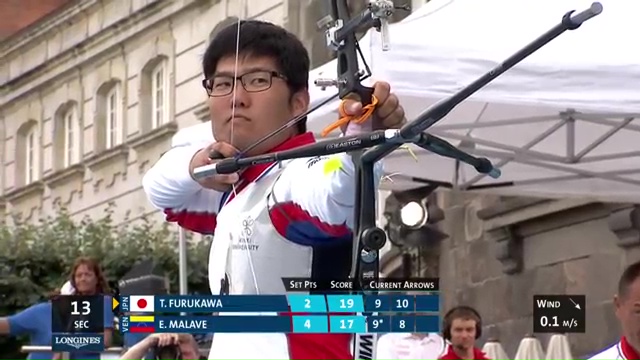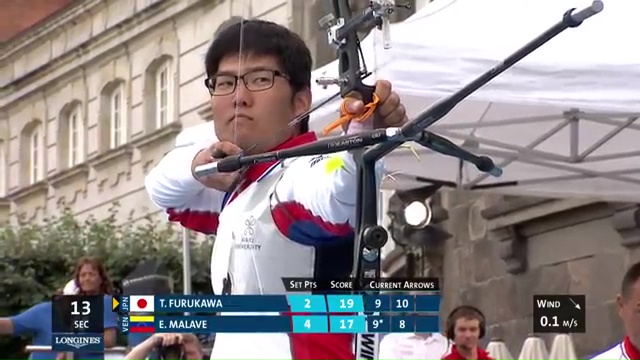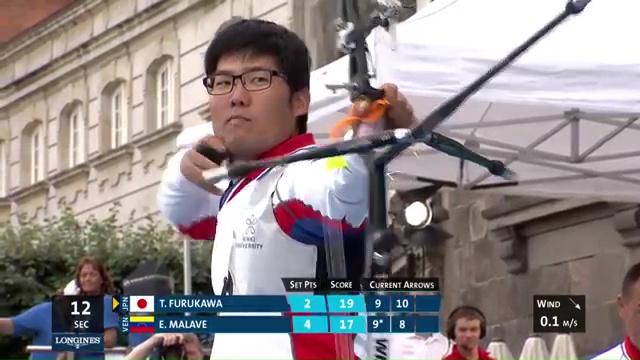With an ideally perfect stabilizer system, during the power stroke the end of the fixed stabilizer (anything before any damping rubber) should remain almost stationary and torque generated on the riser from the bow recoil accommodated by long rod flexure (in the sense of the long rod bowing upwards). Once the arrow has left the string the recoil torque will disappear and the rod will naturally straighten under the existing rod elastic forces. As the weight end of the long rod is much lighter than the riser end this straightening will basically involve an upwards acceleration of the end weight of the long rod.
We can maybe infer the long rod stabilizing behaviour somewhat from looking at videos of the behaviour of any end weight fitted past any vibration dampening rubber in the
long rod system.(Note: There is always the possibility that long rod rotation is a consequence of the archer's behaviour rather than the stabiliser system).
The following photos capture the long rod behaviour in a number of cases. Quite a few videos have been viewed and in the majority of cases no riser rotation is visible. In all these cases where a damper end weight is in place the end weight is seen to flick upwards. In the rare cases where riser rotation is visible then little or no flick upwards of the end weight is observed. What you get has a bit of luck about it as you are frame stepping through a normal speed video.



The first frame carries the arrow streak in the image so just post launch. Little downward bend of the weight beyond the self weight flex so little rod rotation (good stabilization). The second frame shows the upward flick of the end weight resulting from the long rod straighting. The third frame shows the first flex of the subsequent end weight oscillation.
The first frame is prelaunch with the slight end weight droop under its own weight. The second frame is just postlaunch showing the arrow streak, The third frame shows the rod straightening flick up of the end weight and the fourth frame is the first flex the subsequent end weight oscillation. Again the lack of rod rotation during the power stroke indicates very good stabilisation.
The first frame is prelaunch with the slight end weight droop under its own weight. The second frame is just postlaunch showing the arrow streak, The third frame is the next frame with the arrow gone. The second frame indicates some visible rotation of the long rod during the power stroke (reference the rod to the KIA logo). That there is no flick up in the third frame seems to indicate the lack of bending of the long rod as a consequence of the rotation. The conclusion would seem to be that this set of photos indicates that the bow stabilisation is not as good as the first two examples. The reason for this could be that while the first two archers have long rod end weight positioned before as well as after the rubber damper, the Japanese archer only has rod end weight positioned after the rubber damper. Weight after the damper contributes only to the bow balancing aspect of stabilization and not to dynamic stabilization.
For comparison: Same archer winning individual recurve bronze medal at Copenhagen World Championships 2015



First frame is prelaunch with the slight end weight droop under its own weight. The second frame is just postlaunch showing the arrow streak. The third frame shows the upward flick of the end weight resulting from the long rod straighting. Indicates good stabilization.
Good stabilization.Very little post shot flick up of weight suggests maybe very stiff damper or stiff long rod combined with good COG position.
Good stabilization
Some riser rotation seen post arrow exit.(Refer the long rod postion to the flags behind it). No consequent flip up of end damper weight. Question arises; is it the stabiliser system or the archer's technique causing this behaviour.
New 21 August 2014